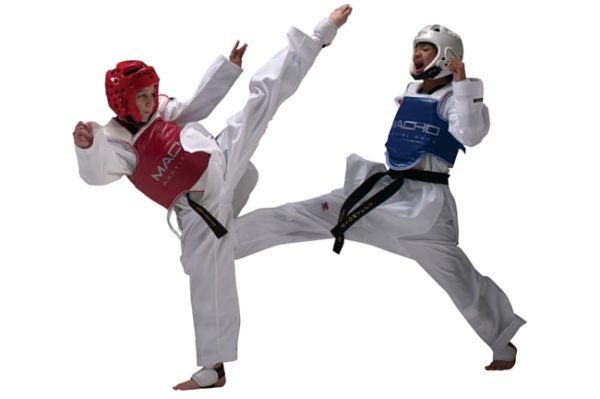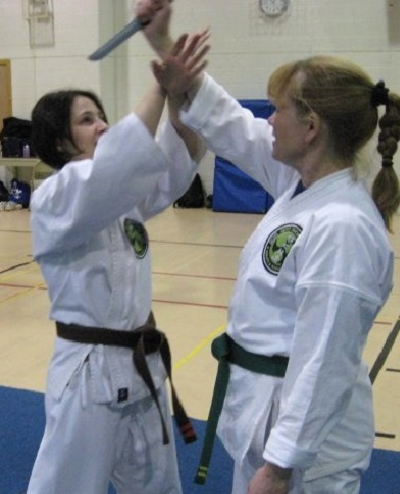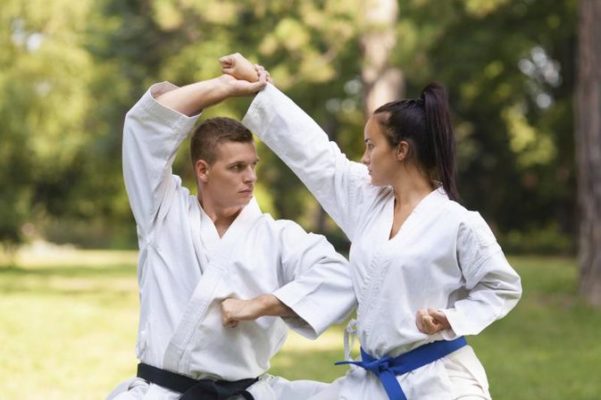How a training partner makes you weak.
by Damian Ross
Founder, The Self Defense Company
There is no “give and take” in self defense. You’re either attacking or being attacked – you’re either hitting or being hit – it’s just that simple.
And it is always better to “give” than it is to receive.
Many people are still under the impression that you need a training partner for self defense when the opposite is true because training on a live training partner will have a negative impact on your effectiveness because you will develop extremely bad habits in your subconscious that will have grave ramifications.
Remember – this is not martial arts – it’s self defense and there’s a huge difference.
Martial arts and combat sports REQUIRE TRAINING PARTNERS for sparring and competition that is a fact. You need this because you actually have to train in the sport – which is designed for SAFETY. On the other hand in self defense you need to ATTACK with ZERO regard for your target. That means 100% POWER and NO STOPPING.
I’ve trained thousands of people to survive in the worst environments on the planet and the training is always the same – the only difference is if you’re doing it next to someone or alone.
The following are popular misconceptions about partner training in self defense.
1. You need to know what it’s like to “get hit” and work with on a real person.
In firearms training do you need to know what it’s like to get shot? NO. If you train knife defense do you need to get stabbed? NO.
There are thousands (if not millions) of soldiers and cops who at the moment of truth fired their weapons and survived, all without ever being shot. Thousands of people have been stabbed and didn’t even know they were stabbed until after the fight was over. You can see hundreds of gruesome images on google.
Feeling what it’s like to get hit isn’t needed for self defense. On the other hand if you “spar” in the street and allow your attacker to set up and hit you first – you’re probably going to lose.
In a fight you’re either hitting to getting hit. There is no exchange – he hits me and I counter with another strike, that only happens in sport and the movies. In a real fight he’s going to come at you with a barrage of attacks, punching, stabbing, kicking, biting – he wants to end you as fast as possible. That first strike will lead to two, four, six, you’re out.
The only way to avoid this is to position yourself at the correct distance so you can gain the advantage BEFORE the physical attack occurs. Any system that teaches you to wait and block an attack will get you killed. PERIOD.
One more important point is the amazing effects of adrenaline. In a real fight you will not even feel the punch that grazes you, the stab or even the gun shot. You will be able to keep going as long as you attack and train yourself to flip the switch and GO. It doesn’t matter what he does, what matters is where he is…
2. Sparring helps with self defense.

Other than standing in front of a real person who wants to hit you, sparring has little to do with self defense. The object of sparring is to score points, make them tap or in some cases, knock them out by striking specific target areas. The purpose of sparring isn’t to maim, injure or kill your target. Sparring is designed for safety, good sportsmanship and entertainment.
But that’s not all…in sparring you wear protective gloves and equipment in a safe, controlled environment. Striking someone for real without a glove and a hand wrap could have disastrous and painful results. Broken knuckles will render your hand useless, not only to strike, but to hold a weapon. In the street you need to strike in a way that prevents your hand from being injured.
In sparring you face someone of your same size, age, sex and experience (the more contact in the sport, the more restrictive these requirements). In the real world you will be targeted by someone who thinks they can dominate you. That means they’re going to be bigger, have friends will most likely have a weapon. In the real world, it’s never going to be a fair fight. So don’t fight fair.
Sparring is consensual – there is a time and a place for your fight. One of the biggest challenges you face in the street is uncertainty. If you’re not trained correctly you won’t know if he’s going to attack or he’s just posturing.
If you don’t know what to look for, he’ll get the drop on you and one shot is all he’ll need. You need to put yourself in a position so that you can smoke out any physically aggressive technique before it happens.
The ability to do this is more crucial for civilians. Soldiers in the battle field and Cops responding to a call are mentally prepared to have enemy contact. They expect it. They have an idea who the bad guys are and they have a plan to deal with them.They also have a good idea WHEN they’re going to face the enemy.
But when they’re off duty, they face the same problems as you, uncertainty.
You also must train to “win every time”. You can afford to lose in the ring, but you can’t afford to lose in the street. There is clearly one winner and it’s you and to develop the right mindset you must win each and every time.
3. Your training partner isn’t really trying to kill you.

This makes all the difference in the world. When you train with a partner and it’s your turn, they let you win. Your partner can go fast and hard but if they accidentally hit you, they’ll immediately stop and apologize and you’ll go put some ice on it.
The intention of your attacker is to injure, murder or rape you. They are planning to WIN, not letting you win. This changes EVERYTHING – you do NOT want to give this person ANY CHANCE of landing an attack. The results will be very bad for you.
4. Training with a partner gives you a false sense of confidence.
You “think” your techniques work because your partner stops when you pretend to hit him. You think you can really strangle because your partner taps. But that’s really only a fraction of the force you need to REALLY strangle someone until they’re out cold.
You pull your punches and you stop your strangles because you don’t want to hurt your partner, which is a good thing. If you really want to hurt another human being in practice you’re either a psychopath, asshole or both.
The problem is in order to develop real power you need to practice at 100% force. It’s like lifting weights. If you use the same weight every day you will not get stronger. Practicing at 100% is the only way to develop real power needed for the street.
To get the power you need you need to go against resistance and in this case, it’s not weights but the force you put into striking, strangling, stabbing and gouging into a training dummy.
Training is about developing habits.
If you train to pull your strikes in practice – you will in the street. .
If you train to stop at the tap in practice – you will in the street.
You practice how you play and if you practice pretending to hit someone, then that’s what you’ll do.
5. Partner training teaches you to wait to be attacked.
Typical self defense training looks like this: your partner attacks you and you defend.
Just the fact that you’re standing in close range to a potential threat waiting to see what they do is a problem. You’re waiting for someone who is intent on hurting you to strike, grab, stab or bludgeon you first…this is INSANE. Yet everyone who’s ever taken a self defense class has done this exact same thing!!
Oh and is there a wrist grabbing epidemic I don’t know about? I don’t know why every system in the world spends so much time on this.
Let me save you the trouble…JUST HIT AND KEEP HITTING.
6. How do you practice an eye gouge?
Or a bite, or a knockout blow or a throat crush or a stab? How do you really know how to stab something?
I have to chuckle at “knife fighting” experts who spend time dancing with their weapons like peacocks and never, ever practice stabbing ANYTHING! I remember training in Filipino Martial Arts and taking several knife fighting seminars where all we did was stand in rows and stab the air.
Holy crap what a circle jerk.
Let me save you some more time.
Knife fighting requires you hold on to the weapon and plunge it into your attacker as many times as possible. There are a few major target areas on the body that will accelerate your desired result and avoid large bone structures, and a few different blades and grips. But for the most part, put the pointy end in the bad guy as much as possible with as much force as possible and don’t let go.
Protect the weapon at all times.
In order to do that you need to practice stabbing something. (We show you exactly how to do this in SDTS Module 9).
If you’re going to do it, you need to REALLY do it. You can’t just say you’ll just gouge the eyes, bite or squeeze his testicles you need to really train this. Grip the head, plunge the thumbs into the eyes, squeeze and scoop while you shake the head. Repeat as needed.
You can’t do that with a partner and you shouldn’t, that’s why we train the way we do.
Self defense requires you to do one thing: survive at all costs.
There are 3 segments, Awareness, Escape and Domination.
Your best chances of survival when you need to use force (Escape and Domination) depend on your ability to strike first, strike fast and strike hard (NO MERCY SIR!).
The better you can do this, the greater your chances of survival.
You don’t wait , you go.
SDTS Combatives is something you do to someone, not with someone. You don’t care what your attacker does do because you’re not going to give him the chance. You’re going to try to avoid fighting, but once he crosses that line you’re going to attack you with NO REGARD.
That means when you train your technique you need to go 100% power. This is the only thing that will build real skill and intent.
There are only two times to train with a partner: using non-lethal techniques for security and law enforcement or do some grappling to see how you can position yourself to use the SDTS ground techniques, but even that only requires a few times before you see the vulnerability of sport martial arts.
Go hard, go fast, go first.
Don’t Be Afraid. Be Feared. Go HERE
![]()



